�
Product Documentation
The documentation for this product includes the manuals listed below. Please
be sure to read all instructions thoroughly to get the most from your camera.
Quick Start Guide
The Quick Start Guide takes you through the process of unpacking and set-
ting up your Nikon digital camera, taking your first photographs, and trans-
ferring them to your computer.
Guide to Digital Photography
The Guide to Digital Photography (this manual) provides complete operat-
ing instructions for your camera.
Nikon View 5 Reference Manual
The Nikon View 5 Reference Manual can be found in electronic format on
the reference CD provided with your camera. For information on viewing
the Reference Manual, see the Quick Start Guide .
CAUTION: Foreign Matter on the CCD
Nikon takes every possible precaution to prevent foreign matter from coming into con-
tact with the CCD during production and shipping. The D100, however, is designed to
be used with interchangeable lenses, and foreign matter may enter the camera when
lenses are removed or exchanged. Once inside the camera, this foreign matter may
adhere to the CCD, where it may appear in photographs taken under certain conditions.
To prevent foreign matter from entering the camera, do not exchange lenses in dusty
environments. To protect the camera when no lens is in place, be sure to replace the
body cap provided with the camera, being careful to first remove all dust and other foreign
matter that may be adhering to the body cap.
Should foreign matter find its way onto the CCD, clean the CCD as instructed on pages
186–187 of this manual, or have the CCD cleaned by authorized Nikon service person-
nel. Photographs affected by the presence of foreign matter on the CCD can be re-
touched using the clean image options available in some third-party imaging software.
How to Read This Manual
First, be aware of the warnings, cautions, and notices on pages ii–vii.
Next, read “Overview” and “Getting to Know
the Camera” to familiarize yourself with the
conventions used in this manual and the names
of camera parts, then set up your camera as de-
scribed in “First Steps.”
Now you are ready to take photographs and
play them back.
Once you have mastered the basics of digital
photography, you can read these sections for
complete information on when and how to use
camera controls.
Read this chapter for more on thumbnail play-
back, playback zoom, and photo information.
Refer to these chapters for information on cam-
era menus and custom settings…
…on connecting your camera to a television or
computer…
…and on optional accessories, camera care, and
troubleshooting.
Overview
Getting to Know the Camera
First Steps
Basic Photography
Basic Playback
Choosing a Shooting Mode
Image Quality and Size
Sensitivity (ISO Equivalency)
White Balance
Image Adjustment
Focus
Exposure
Flash Photography
Self-Timer Mode
More About Playback
Menu Guide
Connections
Technical Notes
i
�
For Your Safety
To prevent damage to your Nikon product or injury to yourself or to others,
read the following safety precautions in their entirety before using this equip-
ment. Keep these safety instructions where all those who use the product will
read them.
The consequences that could result from failure to observe the precautions listed
in this section are indicated by the following symbol:
This icon marks warnings, information that should be read before us-
ing your Nikon product to prevent possible injury.
WARNINGS
Do not look at the sun through the
viewfinder
Viewing the sun or other strong light
source through the viewfinder could
cause permanent visual impairment.
Turn off immediately in the event
of malfunction
Should you notice smoke or an un-
usual smell coming from the equip-
ment or from the AC adapter (avail-
able separately), unplug the AC
adapter and remove the battery im-
mediately, taking care to avoid burns.
Continued operation could result in
injury. After removing the battery,
take the equipment to a Nikon-autho-
rized service center for inspection.
Do not use in the presence of flam-
mable gas
Do not use electronic equipment in
the presence of flammable gas, as this
could result in explosion or fire.
Do not place strap around neck
Placing the camera strap around your
neck could result in strangulation.
Special care should be taken to avoid
placing the strap around the neck of
an infant or child.
ii
Do not disassemble
Touching the product’s internal parts
could result in injury. In the event of
a malfunction, the product should be
repaired only by a qualified technician.
Should the product break open as the
result of a fall or other accident, re-
move the battery and/or AC adapter
and then take the product to a Nikon-
authorized service center for inspec-
tion.
Observe proper precautions when
handling batteries
Batteries may leak or explode if im-
properly handled. Observe the follow-
ing precautions when handling batter-
ies for use in this product:
• Be sure the product is off before re-
placing the battery. If you are using an
AC adapter, be sure it is unplugged.
• Use only batteries approved for use in
this equipment.
• Do not attempt to insert the battery
upside down or backwards.
• Do not short or disassemble the bat-
tery.
• Do not expose the battery to flame or
to excessive heat.
• Do not immerse in or expose to water.
• Do not transport or store with metal
objects such as necklaces or hairpins.
�
• When the battery is not in use, attach
the terminal cover and store in a cool
place.
• Immediately after use, or when the
product is used on battery power for
an extended period, the battery may
become hot. Before removing the
battery, turn the camera off and allow
the battery to cool.
• Batteries are prone to leakage when
fully discharged. To avoid damage to
the product, be sure to remove the
battery when no charge remains.
• Discontinue use immediately should
you notice any changes in the battery,
such as discoloration or deformation.
Use appropriate cables
When connecting cables to the input
and output jacks, use only the cables
provided or sold by Nikon for the pur-
pose, to maintain compliance with
product regulations.
Keep out of reach of children
Particular care should be taken to pre-
vent infants from putting the battery
or other small parts into their mouths.
Removing memory cards
Memory cards may become hot dur-
ing use. Observe due caution when
removing memory cards from the
camera.
CD-ROMs
The CD-ROMs on which the software
and manuals are distributed should
not be played back on audio CD
equipment. Playing CD-ROMs on an
audio CD player could cause hearing
loss or damage the equipment.
Observe caution when operating
the flash
Using the flash close to your subject’s
eyes could cause temporary visual im-
pairment. Particular care should be
observed if photographing infants,
when the flash should be no less than
one meter (39˝) from the subject.
When using the viewfinder
When operating the diopter adjust-
ment control with your eye to the
viewfinder, care should be taken not
to put your finger in your eye acciden-
tally.
Avoid contact with liquid crystal
Should the monitor break, care should
be taken to avoid injury due to broken
glass and to prevent liquid crystal from
the monitor touching the skin or en-
tering the eyes or mouth.
iii
�
Caring for the Camera and Battery
Do not drop
The product may malfunction if subjected
to strong shocks or vibration.
Keep dry
This product is not waterproof, and may
malfunction if immersed in water or ex-
posed to high levels of humidity. Rusting
of the internal mechanism can cause irrepa-
rable damage.
Avoid sudden changes in temperature
Sudden changes in temperature, such as
occur when entering or leaving a heated
building on a cold day, can cause conden-
sation inside the device. To prevent con-
densation, place the device in a carrying
case or a plastic bag before exposing it to
sudden changes in temperature.
Keep away from strong magnetic fields
Do not use or store this device in the vicin-
ity of equipment that generates strong
electromagnetic radiation or magnetic
fields. Strong static charges or the mag-
netic fields produced by equipment such as
radio transmitters could interfere with the
monitor, damage data stored on the
memory card, or affect the product’s inter-
nal circuitry.
Do not touch the shutter curtain
The shutter curtain is extremely thin and
easily damaged. Under no circumstances
should you exert pressure on the curtain,
poke it with cleaning tools, or subject it to
powerful air currents from a blower. These
actions could scratch, deform, or tear the
curtain.
Handle all moving parts with care
Do not apply force to the battery-chamber,
card-slot, or connector covers. These parts
are especially susceptible to damage.
iv
Cleaning
• When cleaning the camera body, use a
blower to remove dust and lint, then wipe
gently with a soft, dry cloth. After using
your camera at the beach or seaside, wipe
off any sand or salt using a cloth lightly
dampened with pure water and then dry
your camera thoroughly. In rare in-
stances, static electricity produced by a
brush or cloth may cause the LCD displays
to light up or darken. This does not indi-
cate a malfunction, and the display will
shortly return to normal.
• When cleaning the lens and mirror, re-
member that these elements are easily
damaged. Dust and lint should be gen-
tly removed with a blower. When using
an aerosol blower, keep the can vertical
(tilting the can could result in liquid being
sprayed on the mirror). If you do get a
fingerprint or other stain on the lens,
apply a small amount of lens cleaner to a
soft cloth and wipe the lens carefully.
• See “Technical Notes: Caring for Your
Camera” for information on cleaning the
CCD.
Storage
• To prevent mold or mildew, store the
camera in a dry, well-ventilated area. If
you will not be using the product for long
periods, remove the battery to prevent
leakage and store the camera in a plastic
bag containing a desiccant. Do not, how-
ever, store the camera case in a plastic
bag, as this may cause the material to de-
teriorate. Note that desiccant gradually
loses its capacity to absorb moisture and
should be replaced at regular intervals.
• Do not store the camera with naphtha or
camphor moth balls, close to equipment
that produces strong magnetic fields, or
in areas subject to extremes of tempera-
ture, for example near a space heater or
in a closed vehicle on a hot day.
�
• To prevent mold or mildew, take the cam-
era out of storage at least once a month.
Turn the camera on and release the shut-
ter a few times before putting the cam-
era away again.
• Store the battery in a cool, dry place.
Replace the terminal cover before putting
the battery away.
Notes on the monitor
• The monitor may contain a few pixels that
are always lit or that do not light. This is
a characteristic common to all TFT LCD
monitors and does not indicate a mal-
function. Images recorded with the prod-
uct will not be affected.
• Images in the monitor may be difficult to
see in a bright light.
• Do not apply pressure to the monitor; this
could cause damage or malfunction.
Dust or lint on the monitor can be re-
moved with a blower. Stains can be re-
moved by rubbing the surface lightly with
a soft cloth or chamois leather.
• Should the monitor break, care should be
taken to avoid injury due to broken glass
and to prevent the liquid crystal from the
monitor touching the skin or entering the
eyes or mouth.
• Replace the monitor cover when trans-
porting the camera or leaving it unat-
tended.
Turn the product off before removing
or disconnecting the power source
Do not unplug the product or remove the
battery while the product is on, or while im-
ages are being recorded or deleted. Forc-
ibly cutting power to the product in these
circumstances could result in loss of data or
in damage to product memory or internal
circuitry. To prevent an accidental interrup-
tion of power, avoid carrying the product
from one location to another while the AC
adapter is connected.
Batteries
• When you turn the device on, check the
battery-level displayed in the control
panel to determine whether the battery
needs to be replaced. The battery needs
to be replaced when the battery-level in-
dicator is flashing.
• Ready a spare battery and keep it fully
charged when taking photographs on im-
portant occasions. Depending on your lo-
cation, you may find it difficult to pur-
chase replacement batteries on short
notice.
• On cold days, the capacity of batteries
tends to decrease. Be sure the battery is
fully charged before taking photographs
outside in cold weather. Keep a spare
battery in a warm place and exchange the
two as necessary. Once warmed, a cold
battery may recover some of its charge.
• Should the battery terminals become
dirty, wipe them off with a clean, dry cloth
before use.
• After removing the battery from the cam-
era, be sure to replace the terminal cover.
Memory cards
• Turn the power off before inserting or re-
moving memory cards. Inserting or re-
moving cards with the power on could
render them unusable.
• I n s e r t m e m o r y
cards as shown in
the illustration at
right. Inserting
cards upside down
or backwards could
damage the cam-
era or the card.
v
�
Notices
• No part of the manuals included with this
product may be reproduced, transmitted,
transcribed, stored in a retrieval system,
or translated into any language in any
form, by any means, without Nikon’s
prior written permission.
• Nikon reserves the right to change the
specifications of the hardware and soft-
ware described in these manuals at any
time and without prior notice.
• Nikon will not be held liable for any dam-
ages resulting from the use of this prod-
uct.
• While every effort has been made to en-
sure that the information in these manu-
als is accurate and complete, we would
appreciate it were you to bring any errors
or omissions to the attention of the Nikon
representative in your area (address pro-
vided separately).
Notice for customers in the U.S.A.
Federal Communications Commission (FCC) Radio Frequency Interference Statement
This equipment has been tested and found
to comply with the limits for a Class B digi-
tal device, pursuant to Part 15 of the FCC
rules. These limits are designed to provide
reasonable protection against harmful in-
terference in a residential installation. This
equipment generates, uses, and can radi-
ate radio frequency energy and, if not in-
stalled and used in accordance with the in-
structions, may cause harmful interference
to radio communications. However, there
is no guarantee that interference will not
occur in a particular installation. If this
equipment does cause harmful interfer-
ence to radio or television reception, which
can be determined by turning the equip-
ment off and on, the user is encouraged to
try to correct the interference by one or
more of the following measures:
• Reorient or relocate the receiving an-
CAUTIONS
Modifications
The FCC requires the user to be notified
that any changes or modifications made to
this device that are not expressly approved
by Nikon Corporation may void the user's
authority to operate the equipment.
Interface Cables
Use the interface cables sold or provided by
Nikon for your equipment. Using other in-
terface cables may exceed the limits of
Class B Part 15 of the FCC rules.
Nikon Inc.,
1300 Walt Whitman Road,
Melville, New York
11747-3064, U.S.A.
Tel.: 631-547-4200
tenna.
• Increase the separation between the
equipment and receiver.
• Connect the equipment into an outlet on
a circuit different from that to which the
receiver is connected.
• Consult the dealer or an experienced ra-
dio/television technician for help.
vi
�
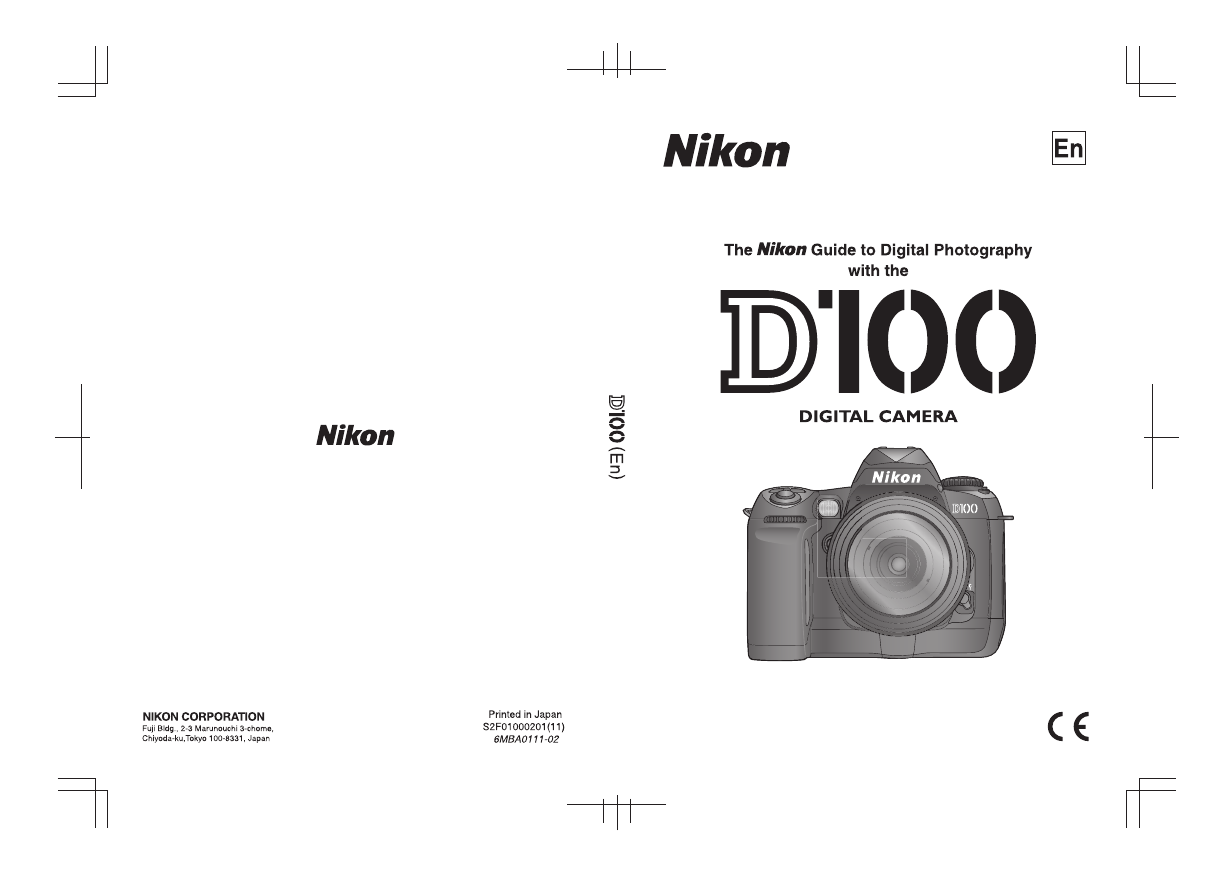
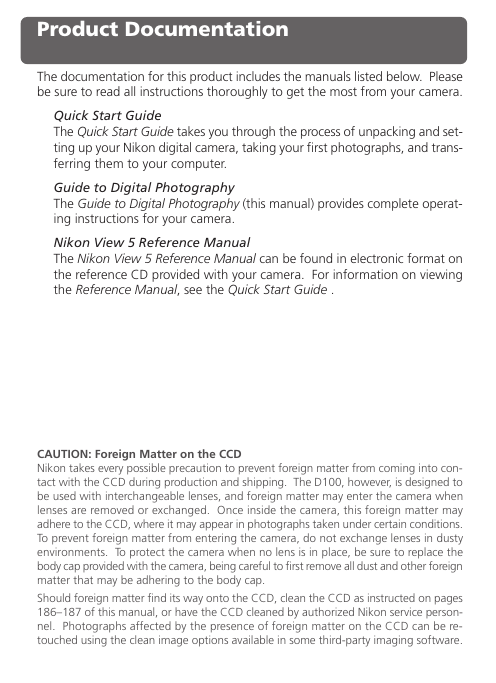


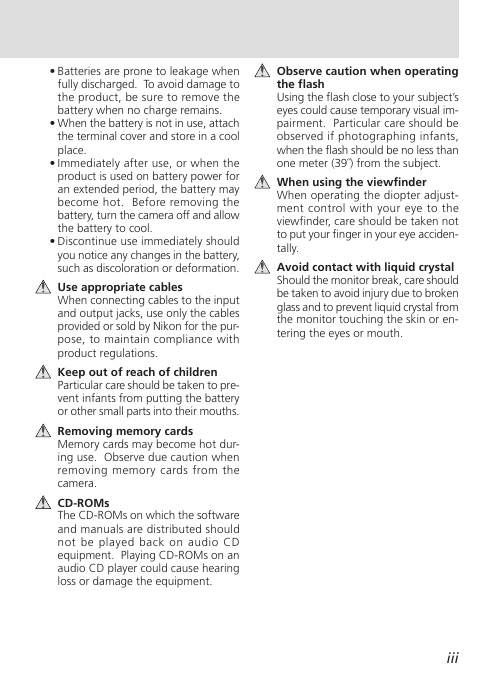
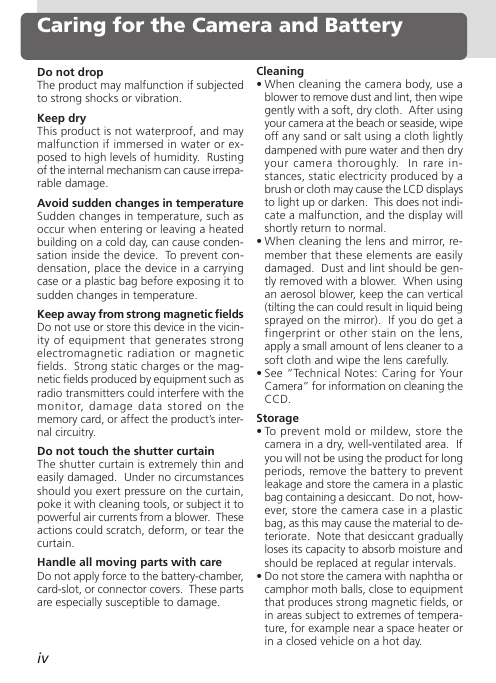
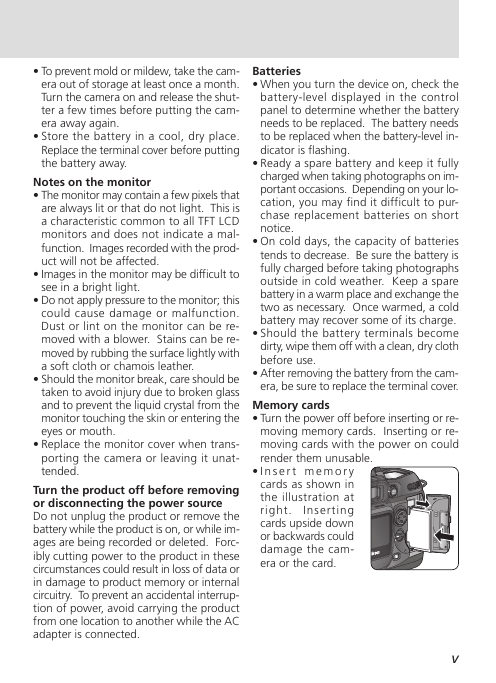
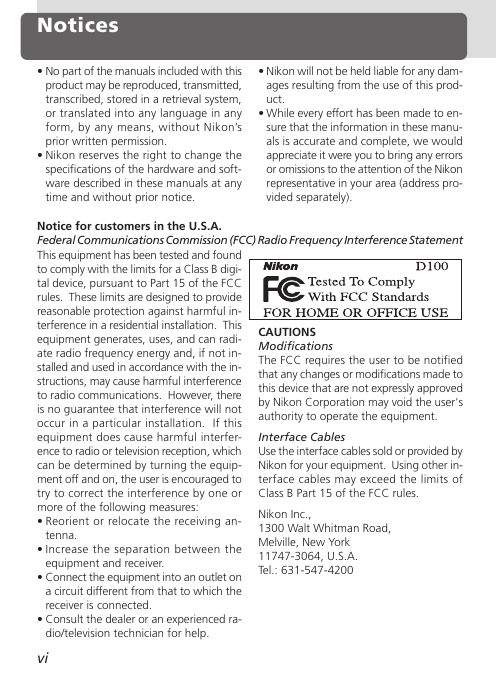








 2023年江西萍乡中考道德与法治真题及答案.doc
2023年江西萍乡中考道德与法治真题及答案.doc 2012年重庆南川中考生物真题及答案.doc
2012年重庆南川中考生物真题及答案.doc 2013年江西师范大学地理学综合及文艺理论基础考研真题.doc
2013年江西师范大学地理学综合及文艺理论基础考研真题.doc 2020年四川甘孜小升初语文真题及答案I卷.doc
2020年四川甘孜小升初语文真题及答案I卷.doc 2020年注册岩土工程师专业基础考试真题及答案.doc
2020年注册岩土工程师专业基础考试真题及答案.doc 2023-2024学年福建省厦门市九年级上学期数学月考试题及答案.doc
2023-2024学年福建省厦门市九年级上学期数学月考试题及答案.doc 2021-2022学年辽宁省沈阳市大东区九年级上学期语文期末试题及答案.doc
2021-2022学年辽宁省沈阳市大东区九年级上学期语文期末试题及答案.doc 2022-2023学年北京东城区初三第一学期物理期末试卷及答案.doc
2022-2023学年北京东城区初三第一学期物理期末试卷及答案.doc 2018上半年江西教师资格初中地理学科知识与教学能力真题及答案.doc
2018上半年江西教师资格初中地理学科知识与教学能力真题及答案.doc 2012年河北国家公务员申论考试真题及答案-省级.doc
2012年河北国家公务员申论考试真题及答案-省级.doc 2020-2021学年江苏省扬州市江都区邵樊片九年级上学期数学第一次质量检测试题及答案.doc
2020-2021学年江苏省扬州市江都区邵樊片九年级上学期数学第一次质量检测试题及答案.doc 2022下半年黑龙江教师资格证中学综合素质真题及答案.doc
2022下半年黑龙江教师资格证中学综合素质真题及答案.doc